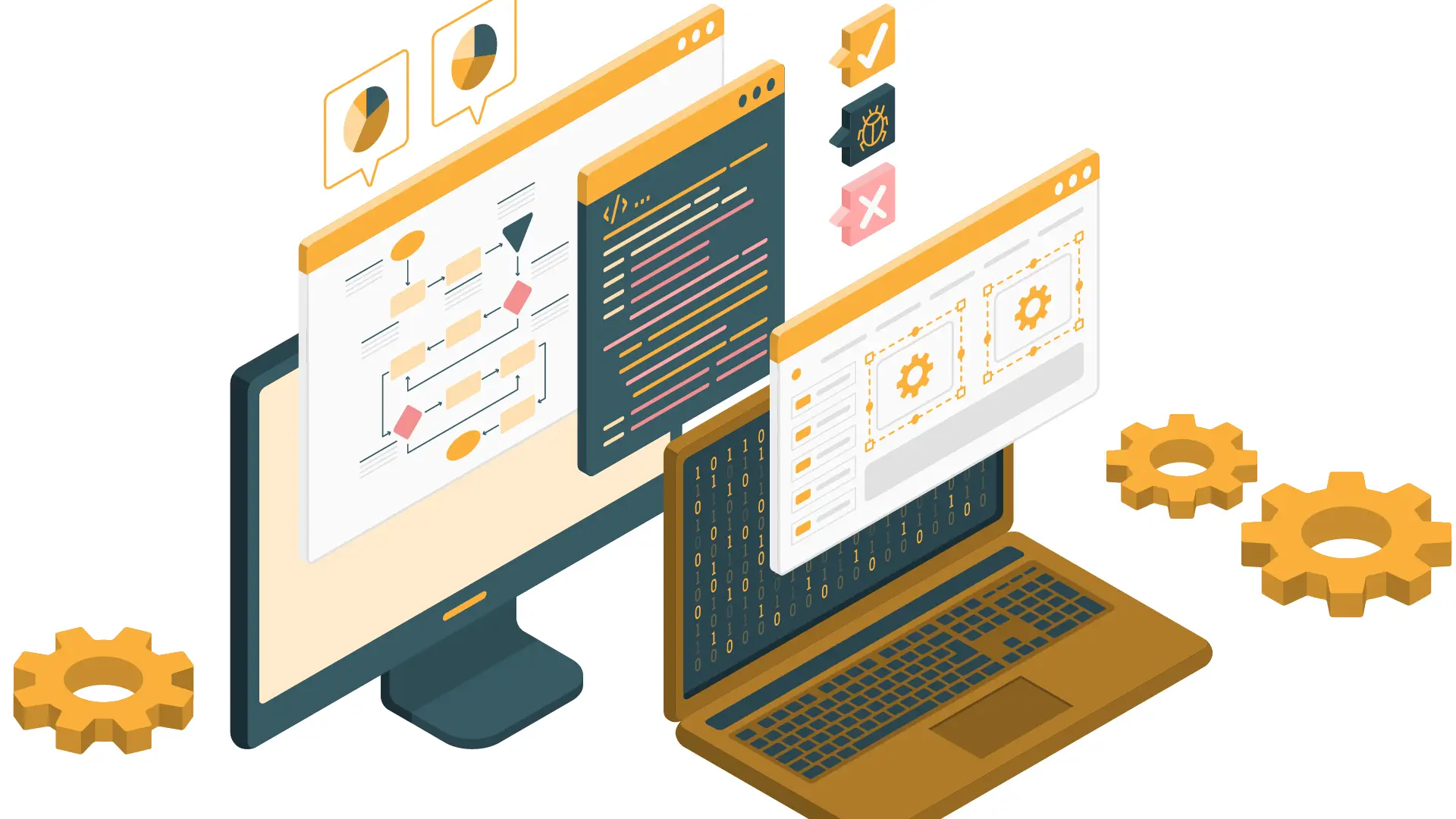Evaluating the ROI of AI-Powered Test Automation Platforms

Artificial intelligence (AI) has transformed the process of Software development from creating and testing to releasing good-quality applications. From automated testing to predictive analytics and decision-making support, leveraging top AI testing tools can lead to significant cost savings and innovative opportunities. However, it is essential for evaluating return on investment (ROI) in AI-driven platforms. It helps in managing strategic decisions, ensuring stakeholder consent, and sustaining long-term competitive advantage.
Understanding an AI-Powered Test Automation Platform
AI testing platforms are automated solutions that use AI and Machine Learning (ML) to build test cases based on historical data, code patterns, and projected results. This capability can be extremely valuable for investigating edge cases or other vulnerabilities that regular methods may not detect.
AI testing platforms can integrate with CI/CD tools and facilitate the implementation of automated tests throughout the development process. This allows teams to fix issues before they are put into production, identify errors more quickly, and receive feedback in real-time.
These AI-powered tools can detect failure patterns on tests and target areas with a high failure rate, to optimise test cases. The most effective test paths can also be generated based on data trends and natural language processing (NLP) models, and minimise redundancy in test cases by maximising productivity with the help of AI.
Overview of ROI
ROI is an estimation of an organisation’s operational and economic benefits against its expenses. Through quicker test cycles, less manual labour, and early bug detection, it assists in determining whether the investment in test automation, such as tools, development time, and maintenance, results in measured savings.
With the introduction of artificial intelligence, organisations are integrating AI-driven ROI that considers enhancements in user experience, productivity, efficiency, and risk reduction. The ROI metric can be used to understand whether AI offers benefits to organisations. Such benefits include lower expenses, increased revenue, and better user satisfaction.
Key Metrics for Measuring ROI of AI-Powered Test Automation Platforms
Below are some of the key metrics for measuring the ROI of AI-powered test automation:
- Shorter Cycle Time and Quicker Development: A number of AI-powered techniques that usually lead to faster development cycles are code generators and automated testing. By monitoring the rate at which features or fixes are developed and deployed, organisations can assess the time savings of integrating AI. One important indicator of success is the reduction in cycle time, from development to delivery, made achievable by automation and more intelligent workflows.
- Improvements to Code Quality (Maintenability, Defect Rates): Machine learning techniques also contribute to better code quality. By monitoring defect rates and the frequency of necessary code revisions, organisations can evaluate the impact of AI on bug reduction and software maintenance.
- Productivity of developers: AI tools and platforms make it easier to create, debug, and test code, directly boosting developers’ productivity. Organisations can utilise metrics such as code production, task completion time, and developer satisfaction to measure the efficiency advantages of AI. However, it is crucial to balance quantity and quality, and the time required for project completion should account for whether or not projects are being completed with fewer errors or rework.
- User Satisfaction and KPIs: Despite the importance of internal development metrics, AI-driven development should be in line with observable end-user results. User happiness, net promoter score, and user retention are metrics that show how faster application delivery and improved application quality improve the overall user experience. Furthermore, tracking key performance indicators (KPIs) like market share, revenue growth, and new user acquisition can show how AI helps organisational success.
The Significance of Evaluating the ROI of AI-Powered Test Automation Platforms
Many organisations are investing in AI without a systematic methodology to assess its efficacy due to the rapid surge in AI usage. Organisations bear the risk of misallocating resources, putting inadequate AI solutions into place, or not getting executive support for upcoming AI expenses if they do not have a strong grasp of AI-driven ROI. Its evaluation is crucial for a number of reasons.
- Rationalising AI Investments: AI initiatives require a large capital investment and may often require new infrastructure, skilled teams, and ongoing management. Specific returns make it easier to secure resources while maintaining management support.
- Alignment of Strategy: AI has the potential to be used to accomplish organisational objectives. Some of these objectives are to increase efficiency in operations, improve user experience, and create additional revenue. AI evaluation of ROI guarantees thoughtful and wise strategic implementation of AI.
- Optimisation of Resources: Not every AI project has the same degree of effect. Organisations can ensure that AI investments significantly contribute to organisational growth by prioritising high-impact projects and discontinuing underperforming ones with the support of a clear understanding of AI ROI.
- Savings on expenses; By automating repetitive operations and minimising the need for manual intervention, artificial intelligence lowers labour expenses. AI-driven predictive maintenance in supply chain management can reduce equipment downtime and significantly save operating costs.
- Growth in Revenue: It assists organisations to enhance their application and personalise user experiences. They can also maximise revenue by using AI-based analytics that will provide better insights into user behaviour.
- Efficiency in Operations: Artificial intelligence promotes efficiency. It streamlines the decision-making and resource allocation process by giving organisations time to work on other key developments. AI chatbots free up human testers by answering a large number of common service queries of end users for complex issues.
- User Contentment: Customisation enabled by AI enhances user experience and boosts engagement and loyalty. Organisations that deploy AI in their user interactions have much greater ongoing retention rates.
- Innovative Concepts and a Competitive Edge: AI can assist organisations to develop new applications, predict user behaviour and improve R&D. It leads to a more competitive advantage and extra revenue.
Challenges in Achieving a High ROI With AI
AI has the potential to provide extremely high returns on investment, yet it has limitations, just like any other new technology.
- Initial expenses and integration issues- Many organisations may be reluctant to invest in AI adoption because of the huge initial costs. ROI can be reduced in the short term since testers will need to integrate and use AI technologies in their current infrastructure.
- Data Quality and Availability- High-quality and well-organised data is the requirement of a successful artificial intelligence application. AI systems are not able to deliver insights and automation needed to build ROI unless they have precise and relevant data to work with.
- AI Skill Training- Organisations need to make sure that testers possess the requisite skills to integrate and utilise AI technologies to realise ROI.
- AI Bias and Its Impact on ROI- AI systems might accidentally replicate existing biases in their training data. This can lead to unfair behaviour that affects individuals while exposing organisations to reputational damage and regulatory penalties.
- Managing Legal and Compliance Risks- Organisations have to be well informed and keep up with a fast-evolving environment of AI regulations. Failure to comply causes legal problems and loss.
Strategies for Evaluating ROI of an AI-Powered Test Automation Platform
It is critical to use a methodical and comprehensive strategy to precisely calculate the return on investment of AI. Here are a few strategies to guide the evaluation:
- Recognise Use Cases with Significant ROI Opportunities: It is best to begin by determining which areas of the organisation AI can have the most impact. Focus on redundant, labour-intensive or even prone to human error activities. Automation through AI will be able to generate more output and minimise the operating expenses. Focusing on the high-impact use cases will help the AI efforts become aligned with the automation goals and will generate quantifiable results.
- Evaluate Data Preparedness and Scalability: AI systems excel with quality data. Evaluate sources of data in terms of accessibility, accuracy, and completeness. Develop effective data governance processes that can guarantee the accuracy of data, and look at the available internal databases rather than using external databases. Guaranteeing data readiness is vital for the scalability and achievement of AI projects.
- Select the Appropriate AI Tools and Platforms: Selecting the right AI tools and platforms is critical for maximizing efficiency and cost-effectiveness in cloud testing environments. Leveraging open-source technologies and cloud-based AI solutions can reduce infrastructure expenses while ensuring seamless integration with existing systems. An AI-powered test automation platform that aligns well with organizational needs can significantly enhance deployment effectiveness and lower costs.
Within the cloud testing ecosystem, platforms like LambdaTest offer comprehensive capabilities for running manual and automated tests at scale across thousands of environments and real devices. Complementing this, LambdaTest provides an AI testing tool for developers and testers called LambdaTest KaneAI. KaneAI is a GenAI-native testing agent designed to help teams plan, author, and evolve tests using natural language. Built specifically for fast-paced quality engineering teams, it integrates smoothly with LambdaTest’s broader offerings around test orchestration, execution, and analysis.
By incorporating such AI testing tools, teams can automate test creation and maintenance, speed up issue detection, and improve overall software reliability. Moreover, advanced features like predictive analytics and auto-healing capabilities help optimize resources and deliver measurable ROI in cloud testing strategies. This approach empowers organizations to enhance test efficiency while reducing manual overhead and costs.
- Create and Evaluate AI Models: Work alongside diverse teams to create AI models customised for specific use cases. Employ agile methodologies that have the prospect of supporting the concept of ongoing improvement and iteration. Thorough testing is needed to establish the performance and reliability of the model before implementing it on a large scale. During development, this process enables adaptability and affordable modifications.
- Track, Enhance, and Expand: Monitor AI mechanisms to measure their performance with regard to predefined parameters. Collect data to discover the areas that need improvement and adjust accordingly. To maximise benefits, implement successful AI solutions across every stage of the testing cycle after validation.
- Ongoing Enhancement via Feedback Mechanisms: Implement mechanisms that allow continuous feedback to improve AI systems. Such a periodic approach retains the effectiveness and relevance of AI solutions. It helps AI adapt to complex environments and emerging data behaviours. The constant improvement makes AI-driven tests flexible and ensures their sustainability in the long term.
- Enhancing Teams for AI Implementation: Help team members to realise their potential in the field of AI. Invest in training to facilitate the proper use of AI tools and accurate analysis of conclusions to promote innovation.
Conclusion
In conclusion, test automation platforms driven by AI revolutionise the pursuit of high ROI. It provides quicker testing, improved precision, and reduced costs. Incorporating AI can enhance software quality while minimizing time and costs. An AI-driven platform illustrates this progress by combining expert QA knowledge with specific metrics.
This blend successfully tackles testing issues and promotes exceptional software development outcomes. Based on the costs and benefits of test automation, organisations must consider the ROI before making any decisions. Determining ROI guarantees that the investment in automation is in line with the organisation’s objectives and provides the anticipated benefits.




